Albert Einstein once said, “In the midst of every crisis, lies great opportunity.” This is especially true for supply chain management in 2025. AI-driven innovations are changing the game with better efficiency and accuracy. Advanced predictive analytics and machine learning are key to success.
The world of supply chain technology is changing fast. Businesses are using AI to improve their operations. By 2025, AI demand forecasts are expected to grow by 30%1. Also, AI adoption for inventory management has jumped by 40% among small and medium-sized businesses1. This means big opportunities for you and your business.
In this article, we’ll look at how AI is changing supply chains. We’ll see how it improves logistics and operational performance.
Key Takeaways
- AI-driven innovations are expected to increase demand forecasts by 30% in 2025.
- Over 1.5 petabytes of sensitive data will be processed in supply chain systems by 2025, boosting demand for security measures.
- The adoption of AI tools for inventory management has risen by 40% among small and medium-sized businesses.
- AI applications in demand planning offer a 70% reduction in time spent on data analysis.
- The global market for AI in logistics is projected to reach nearly $6.5 billion by 2031.
Understanding AI-Driven Innovations in Supply Chain Optimization
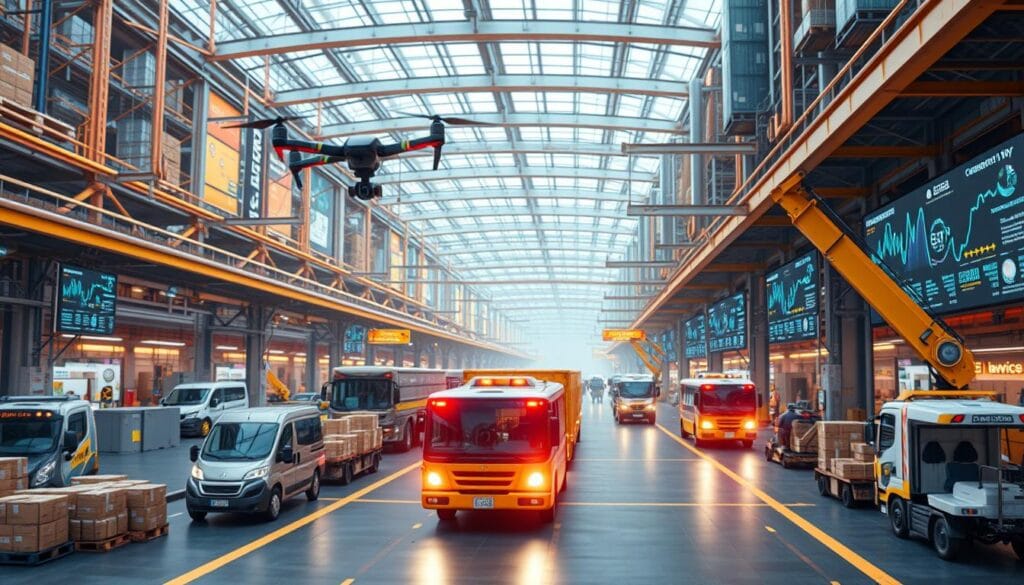
Artificial intelligence is changing how businesses work. It’s making supply chain management better. Now, decisions can be made in minutes, not days, thanks to new tech.
This change boosts productivity. It also helps leaders by automating important tasks. Terms like automation and predictive analytics are key to this success2.
What is AI in Supply Chain Management?
AI in supply chain management uses predictive analytics and machine learning. This improves logistics and makes manufacturing smarter. It helps manage inventory better and ensures deliveries are on time.
Companies using AI can save a lot of money. They might save up to €3.5 million a year. This is thanks to better forecasting and managing inventory34.
Key Terminology You Should Know
To get the most from AI in logistics, learn key terms. Terms like cognitive analytics and prescriptive analytics are important. They help businesses make decisions based on data.
Descriptive analytics helps find trends in big data. This is crucial for managing risks and improving relationships with suppliers. It’s essential for modern supply chain strategies3.
The Evolution of Supply Chain Management
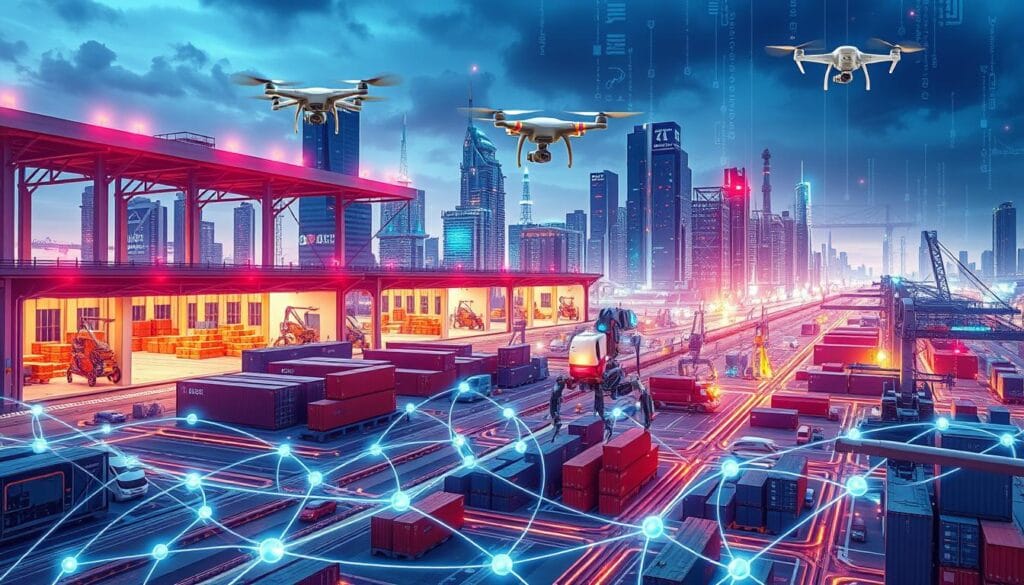
The way businesses work has changed a lot, thanks to supply chain evolution. It’s moved from just handling goods to being key to winning in the market. Knowing the history of supply chain management helps us see how tech has played a big role in this change. Over the last 20 years, supply chains have become more than just cost centers. They’ve become a big part of how businesses compete, especially after COVID5.
Historical Context of Supply Chains
Older days saw companies mainly focusing on cutting costs. But, things like global tensions and natural disasters have made them rethink their plans. In 2024, big disruptions hit supply chains, like a port strike and a bridge collapse6. Now, companies are all about being flexible and resilient. They know keeping a good supply chain is key to doing well.
The Role of Technology in Transformation
Technology has really changed supply chains, especially with advanced analytics and AI. Companies are putting a lot into AI to improve forecasting and manage stock better6. While old AI has been around for years, new Generative AI is opening up new possibilities. Having a strong data system not only saves money but also encourages innovation, which is vital for keeping up with new trends5.
Current Challenges in Supply Chain Management

Supply chains face many challenges today. Economic factors and global events play big roles. These issues affect logistics and make things less efficient.
Economic Factors Influencing Supply Chains
Economic issues like inflation and trade tariffs make things tough. About 47% of supply chain leaders worry about disruptions. They need good strategies to stay stable7.
These problems also raise costs. But, AI could cut these costs by up to 15% by making things more efficient8.
Impact of Global Events on Operations
Global events, like the COVID-19 pandemic, change how we shop. They lead to new consumer habits7. AI is seen as a solution to these problems.
AI can make decisions 30% faster. This helps companies react quicker to changes8. Also, more people want brands that care about the environment. About 60% of consumers prefer eco-friendly brands9.
The Role of AI in Enhancing Efficiency

AI has changed the game for supply chains, making them more efficient. It helps with forecasting and demand planning, leading to better inventory management. Businesses see a 20-30% drop in carrying costs, saving money on excess stock and stockouts10.
AI-Powered Forecasting and Demand Planning
AI forecasting gives a clearer view of future demand, improving accuracy by up to 50% over old methods10. This accuracy helps companies match production with consumer needs, using resources better. As a result, they see a 15-25% boost in operational efficiency, thanks to smarter decisions10.
Streamlining Logistics with Machine Learning
Machine learning is changing logistics management. It lets companies quickly adjust to demand and supply chain issues. AI systems can boost operational efficiency by up to 15%, making sure resources are used well and responding to market changes11.
With AI, companies are investing more in automation and smart routing. This also cuts fuel use by over 15% each year11.
More logistics companies are using AI, with about 60% investing in AI for demand planning. This is setting the stage for better operations that support growth and sustainability in the changing market12.
Big Data and Its Impact on Supply Chains
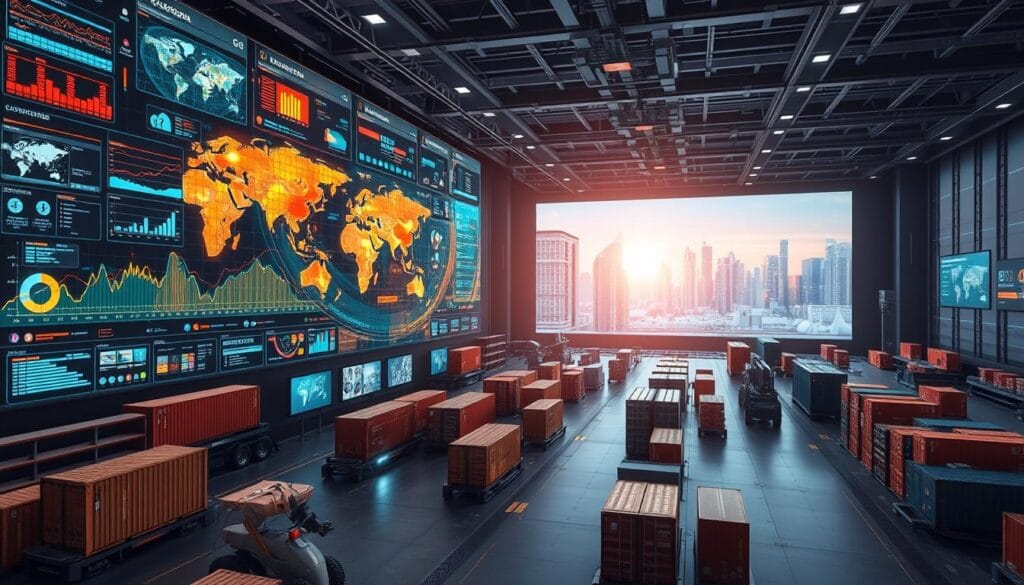
In today’s fast-changing business world, the impact of big data on supply chain strategies is huge. Companies are using detailed data analysis to make their supply chains more efficient and quick to respond. Knowing how to analyze and use data well is key to staying competitive.
Analyzing Data for Informed Decision-Making
Data analysis helps companies turn big data into useful insights. By 2025, 60% of analytics platforms will help the logistics industry make smart decisions fast13. Companies using data analytics have cut their costs by 20-25%, showing the importance of strong analysis13.
Also, better demand forecasting helps match inventory with market needs. This leads to better use of resources.
Real-Time Data Utilization
Real-time data analytics brings big benefits to supply chain management. It lets companies optimize routes, improving efficiency13. Predictive analytics can cut inventory costs by up to 20%, showing the value of timely data13.
Companies like Deutsche Bahn use predictive maintenance to keep operations running smoothly and avoid expensive downtime14. The auto industry uses real-time tracking and predictive maintenance to improve production schedules. This leads to shorter lead times and better product quality14.
Integrating big data into your operations boosts effectiveness and makes your supply chain more resilient. This approach helps you meet changing consumer needs and stay competitive1413.
Predictive Analytics: The Future of Supply Chains
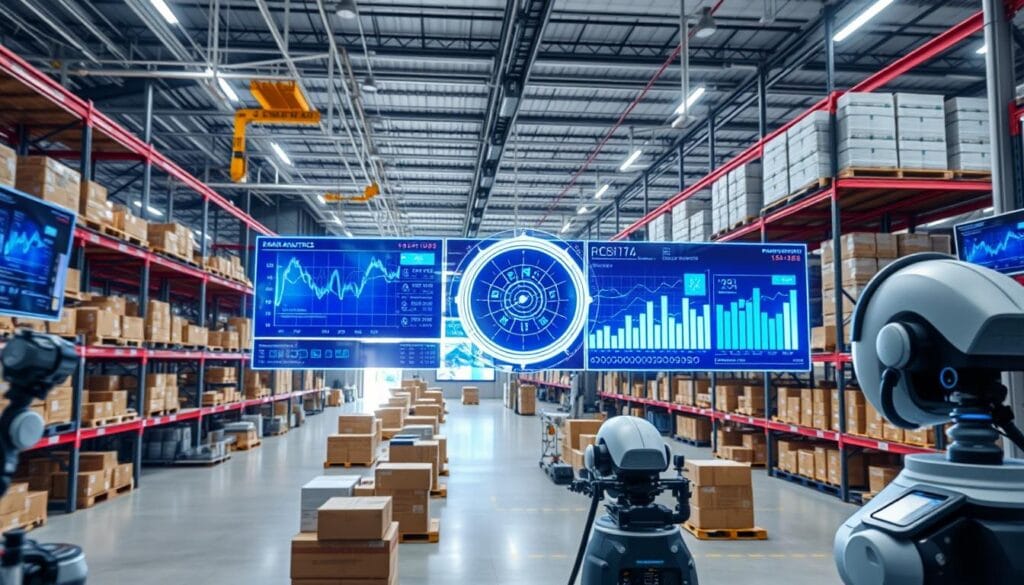
In today’s fast-evolving supply chain landscape, understanding predictive analytics in warehousing is crucial. Predictive models use algorithms and machine learning to analyze data. This helps businesses forecast future trends well. They are key in spotting patterns for better inventory and production planning.
How Predictive Models Work
Predictive analytics uses data to create insights for better decisions. AI tools can predict demand with over 90% accuracy, helping businesses manage production and inventory better15. This leads to less waste and better alignment with customer needs.
Benefits of Forecasting Demand Accurately
The benefits of accurate demand forecasting are huge. Predictive analytics can cut supply chain disruptions by about 30% by spotting risks early15. A big retail company saw a 25% boost in stock accuracy with AI16. Companies using AI and ML in supply chain management could see a 10-15% profit increase over five years15. With these advancements, predictive analytics is set to play a big role in making operations better and improving customer satisfaction.
Automation in Supply Chain Processes

In today’s fast-paced world, making supply chain processes more efficient is key. Technologies like robotic process automation (RPA) make complex tasks easier. This lets companies cut down on mistakes and focus on big decisions.
As more companies turn to automation, keeping up with new trends is essential. They must adjust their ways to stay competitive.
Robotic Process Automation (RPA)
Robotic Process Automation is a big help in making supply chains run smoother. It automates tasks that used to need people. This cuts down on mistakes by 40% and speeds up order processing by 50% compared to doing it by hand17.
With more businesses using technology, RPA is a key player in making things work better and saving money. Companies using RPA see big improvements, like the impact of smartphones in logistics18.
AI-Driven Inventory Management
AI helps manage inventory by adjusting stock levels on its own. This cuts down excess stock by 20%17. It also helps avoid stockouts, reducing disruptions by 30%17.
Using AI for inventory management also boosts accuracy by 25% and cuts costs by 15%19. It makes inventory levels better and improves trust among partners19.
The Importance of Customer Insights
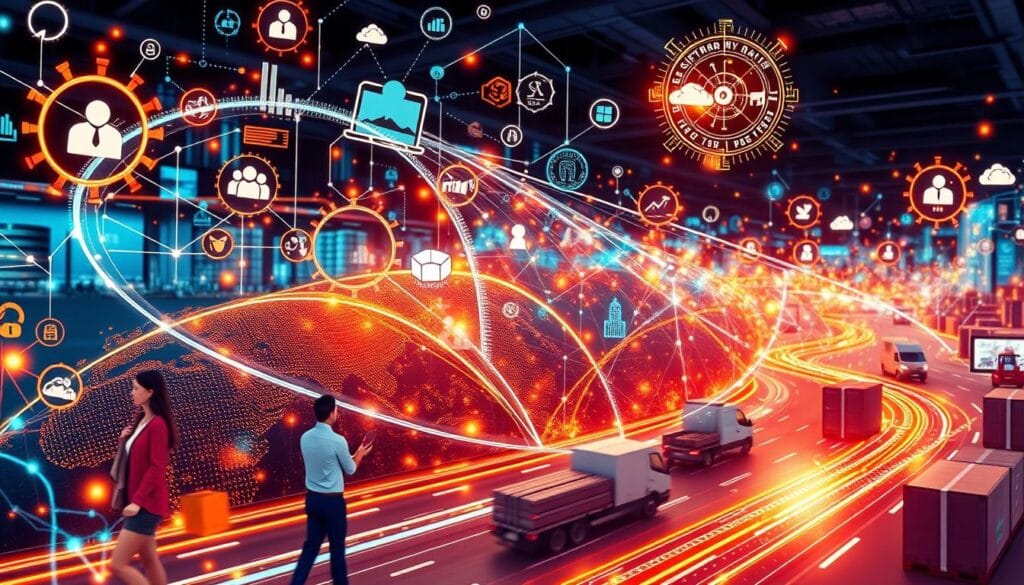
Understanding what customers want is key to a better supply chain. AI helps businesses dig into data to learn about buying habits and trends. This way, stores can adjust to what customers need more easily.
Leveraging AI for Enhanced Customer Experience
AI is changing retail by making insights and decisions better, leading to more profit20. Stores using AI chatbots see a 30% jump in customer happiness in just six months20. This happiness often means customers get their orders on time and know where they are.
Gathering and Analyzing Customer Data
AI helps stores manage their stock better by looking at data. Tools predict demand by checking weather and holidays, avoiding too much or too little stock2021. AI also helps set prices based on what’s in demand, making customers feel valued and loyal20.
Using customer insights in supply chain management makes things more efficient and helps work better with suppliers. This improves the overall shopping experience.
While starting with AI can be tough, the benefits are worth it. As AI becomes more common in supply chains, companies that use it well can grow and stay ahead21.
Real-World Applications of AI in Supply Chains

Learning about AI in supply chain management can be really helpful. Look at how companies like Amazon and Ocado use AI to automate transport and warehouses. They show how AI can do tasks better and faster22. Ikea also uses AI for demand forecasting, combining past and current data for better results22.
These stories teach us the value of planning and starting small when adopting new tech. It’s key to learn from those who have already done it.
Case Studies from Leading Industries
In retail, AI helps with logistics, making routes better and saving time and fuel23. It also helps manage inventory, cutting down on stockouts and backlogs2223. Companies are now mixing local and global supply chains for better resilience and efficiency24.
Lessons Learned from Early Adopters
Early users of AI learned the power of real-time insights and predictions. These tools can cut costs and improve efficiency23. Companies using AI can handle supply chain complexities better, meeting new rules and keeping the environment safe24.
By studying these experiences, your company can be ready to use AI for success.
Sustainability through AI Innovations
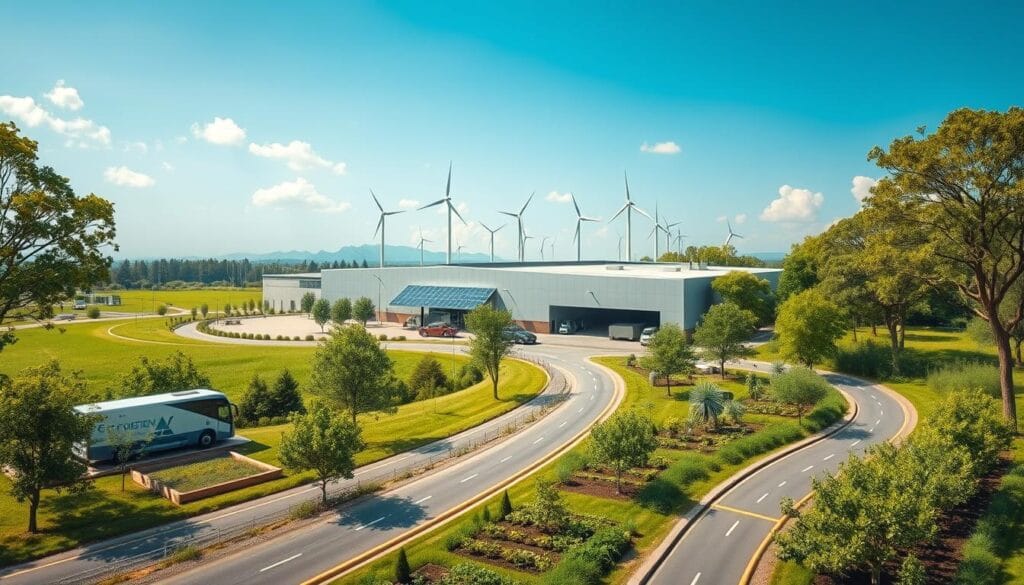
Sustainability is key in supply chain management, thanks to AI. These technologies help businesses use resources better. They find ways to cut waste and make things more eco-friendly.
Companies are using AI to meet their environmental goals. This is a big step forward for a greener future.
Optimizing Resource Allocation
AI makes supply chains more efficient. For example, data analysis boosts efficiency by up to 40%25. This means resources are used right, helping the planet.
AI also helps cut down on emissions in transport by 10%26. It makes sure there’s no extra production, which is good for the environment.
Reducing Waste with AI
Reducing waste is important, especially for things that spoil fast. In coffee, AI tools have cut down on waste a lot26. Automation in logistics makes things run smoother, cutting down on manual work and boosting productivity25.
This automation helps respond to problems faster and supports green practices. By 2025, focusing on sustainable supply chains will be crucial for businesses to stay ahead25.
The Future of AI-Driven Innovations
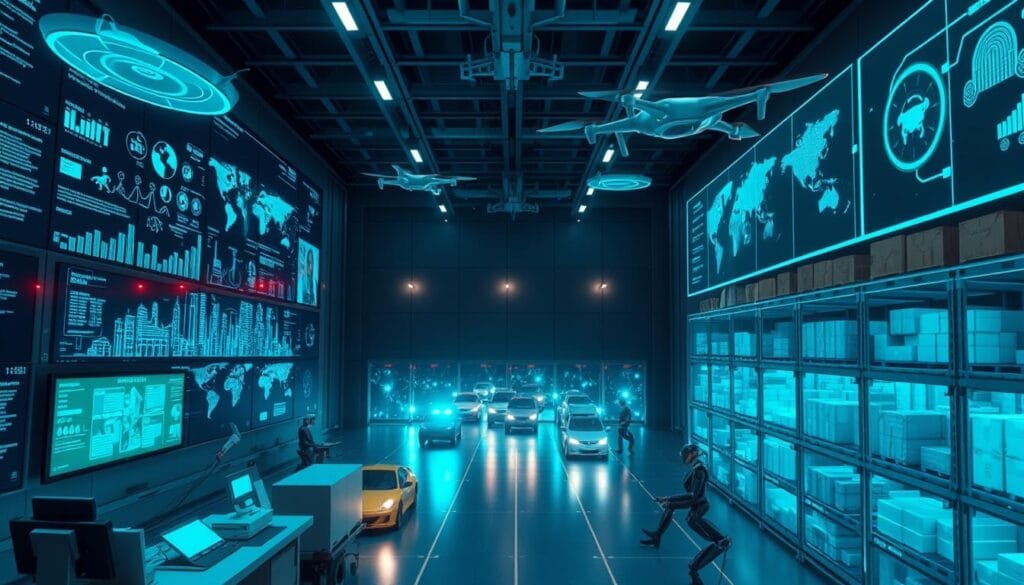
The future of future supply chain technology looks bright, thanks to AI innovations. Trends like intelligent automation and real-time analytics will change the game. They will make networks more efficient and collaborative.
As companies adopt new technologies, they’ll see big changes. They’ll make better decisions and work more smoothly.
Trends to Watch in 2025 and Beyond
Looking ahead to 2025, some trends are really taking off. AI could boost supply chain productivity by up to 50%27. This is a big push for companies to use AI.
AI can also cut inventory costs by 20-30%27. And predictive analytics can cut forecast errors by 75%27. This makes operations more efficient.
AI and IoT will bring real-time data visibility. This lets businesses quickly handle disruptions. It improves decision-making9.
Automation is expected to cut costs by up to 30%28. This will greatly boost profits.
Potential Future Technologies
Technologies like quantum computing and advanced robotics will change supply chains. By 2025, 75% of supply chain firms will use AI tools28. This will make operations more transparent.
AI will also improve forecasting, cutting errors by 20%28. This means better inventory management and fewer stockouts.
These innovations will also help the environment. They could cut carbon emissions by 20% through better logistics28. Sustainability is becoming a big focus, with 60% of companies planning to use AI for it by 202527.
Aligning AI Strategies with Business Goals

To succeed today, you must align AI strategies with your business goals. Setting clear objectives in supply chain management is key. This ensures AI helps your company grow. It’s important to define metrics to track progress and see how well AI works.
Setting Measurable Objectives
Clear, measurable goals help you see how AI affects your work. Research shows companies that align AI with goals grow 50% faster29. This growth comes from better supply chain management and cost cuts.
AI predictive analytics can boost decision-making by 85%29. Using such tools is crucial for reaching your supply chain goals.
Integrating AI Solutions Seamlessly
Integrating AI smoothly into your workflow is essential. It helps avoid disruptions and boosts efficiency. AI can save 30% of employee hours weekly, freeing staff for strategic work29.
Investing in AI that matches your goals is vital. It leads to happier customers and loyalty. Advanced AI can cut delivery times by 25%29.
Overcoming Barriers to AI Integration
Using AI in your supply chain can make things run smoother. But, there are hurdles to overcome. These challenges need smart solutions.
Addressing Skills Gap in the Workforce
The biggest hurdle is the skills gap in the workforce. As companies adopt AI, they must train their teams. This includes skills in data science and AI literacy.
Retraining workers is key to using AI tools well. In fields like logistics and healthcare, special training helps. It makes workers ready for new tech30.
Investment Considerations
Investing in AI is crucial for better operations. But, it’s a big step for businesses. They must weigh the costs against the benefits.
Companies using AI see cost cuts and better service levels. This shows AI’s long-term value30. They also face legal hurdles, like data protection laws30.
Ensuring data quality is vital. Poor data can undermine AI’s effectiveness30.
Ethical Considerations in AI Deployment
AI is changing how we manage supply chains, and we must understand the ethical implications in supply chain. As AI makes more decisions, companies must focus on responsible AI practices. This includes protecting data privacy, avoiding bias, and being transparent. It’s crucial to check if these efforts match your business goals.
Understanding the Ethical Implications
Using AI in supply chains can make things clearer and lower ethical risks. It can even boost compliance by up to 40% for companies using these tools31. Studies show that 70% of procurement leaders believe AI helps them watch supplier compliance better, tackling big ethical issues in buying31.
Companies using AI can spot ethical risks better. They can find about 50% more risks when checking suppliers with AI31.
Best Practices for Responsible AI Use
Regular checks on your AI systems are key to being ethical. By talking to stakeholders, you build trust and make sure your AI follows the rules. A survey found AI can cut down on greenwashing by about 33%, showing your dedication to the environment31.
Also, training your team on ethical sourcing can help them deal with biases. It can make seeing how suppliers perform better by over 60%31.
Preparing Your Organization for AI Innovations
In today’s fast-changing world, getting ready for AI is key for companies wanting to keep up. A good plan starts with teaching your team about AI. This way, they can use AI’s power to make your supply chain work better.
Training and Upskilling Employees
Teaching your team about AI is a smart move. It gives them the skills to handle new tech. This boosts work efficiency and reduces problems when introducing AI tools.
Studies show that training leads to big gains in work quality and innovation. It helps your team smoothly move into a digital world3.
Creating a Culture of Innovation
Building a culture of innovation lets your team try new things. This leads to fresh ideas and solutions. It makes your team feel valued and ready to make big changes.
Also, a culture of innovation helps your company adapt quickly. It uses AI to stay ahead in the market. For more on using AI in your business, read this article on AI in manufacturing9.
Conclusion: Embracing AI for Future Success
AI in supply chain management brings big benefits for your business. A huge 85% of supply chain leaders think AI will give them an edge soon32. Companies using AI for forecasting see stockouts drop by up to 30%, showing big efficiency gains32.
Also, AI in logistics cuts fuel use by 10-15%, saving money and helping the planet32.
When thinking about making your supply chain better, look at the numbers. Only 19% of logistics firms use advanced AI, leaving lots of room for growth33. AI can boost efficiency and customer happiness by up to 25%, making it a smart investment32.
Success with AI also means having a clear plan. Firms without a roadmap struggle to meet their goals32. So, training your team is key to embracing AI and moving forward.
FAQ
What are AI-driven innovations in supply chain optimization?
How does AI impact logistics and supply chain management?
What role does machine learning play in inventory optimization?
What are the main challenges facing supply chains today?
How can predictive analytics enhance warehousing operations?
What is Robotic Process Automation (RPA) and its advantages in supply chain processes?
How does AI contribute to sustainability in supply chains?
What ethical considerations should organizations be aware of when deploying AI?
How can businesses prepare their workforce for AI integration?
Source Links
- 5 AI-Driven Trends Shaping the Supply Chain Planning in 2025 – intelichain
- How Generative AI Improves Supply Chain Management
- Artificial Intelligence in Supply Chain: Revolutionizing Industry 2025
- Artificial Intelligence (AI) in Supply Chain and Logistics
- Supply Chain Trends for 2025
- Our evolving supply chains — a 2025 perspective
- Supplier diversification, AI readiness, and circularity top supply chain…
- Supply Chain Trends for 2025: Innovation, Sustainability, and Resilience
- Top 10 Supply Chain Trends for 2025: Why It’s Time to Rethink and Reinvent
- The Center – Revolutionizing Efficiency: The Role of Artificial Intelligence in Supply Chain Management
- Practical innovations of AI in transportation and logistics for 2025
- The Rise of AI in Supply Chain Technology: Enhancing Efficiency and Predictability – Supply Chain Technology News
- Top Trends in Big Data Analytics for Logistics in 2025
- AI-Driven Supply Chains: The New Standard for 2025
- The Future of Supply Chains: 2024 in Review and Predictions for 2025
- How AI is Streamlining Supply Chain Management in 2025
- AI and Automation: Transforming Supply Chain Management with Scalable Solutions
- 7 Innovative Trends Shaping Supply Chain Technology in 2025
- AI in Retail Industry Transforms Customer Insights in 2025
- Supply Chain Optimization – The Role of AI
- Top 12 Supply Chain AI Use Cases in 2025
- Real World Applications of AI: Transforming Business in 2025
- 2025 Supply Chain Projections
- Anticipating the Future: Supply Chains in 2025
- How AI-Powered Supply Chains are Leading the Sustainability Movement
- The Surge of AI-Driven Innovations in 2025: Transforming Industries and Society
- Future of AI in Supply Chain: What You Need to Know
- How Businesses Can Leverage AI to Transform Their Operations in 2025
- How to Overcome Challenges in Implementing AI in Supply Chain?
- AI in Ethical Sourcing — Navigating ESG Practices in 2025
- AI in Supply Chain Optimisation: Case Studies and Strategies
- AI-driven digital transformation can futureproof the supply chain







